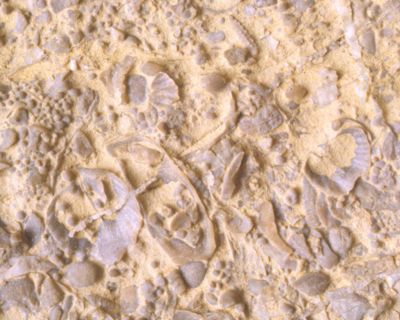Rock (geology): Difference between revisions
Jump to navigation
Jump to search

imported>Nereo Preto (natural) |
imported>Nereo Preto (add figure) |
||
| Line 2: | Line 2: | ||
==Classification== | ==Classification== | ||
[[Image:Biocalcarenite.jpg|thumb|400px|right|Hand sample of a sedimentary rock. This sample comes from the [[Carnian]] (Upper [[Triassic]]) of the Dolomites, and is better described as a [[oolite|oolitic]]/bioclastic [[grainstone]], a kind of carbonate rock. The small spheres in the rock are oolites, all other elements are fossils. Among others, [[brachiopod]]s, [[mollusc]]s and [[echinoderm]] fragments are recognizable in this picture. It is typical of many carbonate rocks to be composed mainly by fossil shells.]] | |||
Rocks can be classified based on their origin. There are thus three main groups of rocks: | Rocks can be classified based on their origin. There are thus three main groups of rocks: | ||
Revision as of 08:54, 1 August 2007
In geology, a rock is a natural aggregate of minerals. Rocks constitute the lithosphere, that is, the part of our planet below the soil.
Classification

Hand sample of a sedimentary rock. This sample comes from the Carnian (Upper Triassic) of the Dolomites, and is better described as a oolitic/bioclastic grainstone, a kind of carbonate rock. The small spheres in the rock are oolites, all other elements are fossils. Among others, brachiopods, molluscs and echinoderm fragments are recognizable in this picture. It is typical of many carbonate rocks to be composed mainly by fossil shells.
Rocks can be classified based on their origin. There are thus three main groups of rocks:
- Sedimentary rocks are formed at the earth's surface by sedimentation of fragments of previously existing rocks, or by chemical precipitation. Most sedimentary rocks are marine.
- Igneous rocks are formed from the solidification of melts, i.e., magmas or lavas. When an igneous rock is formed within the crust, it is called an intrusive rock. Subvolcanic rocks are formed within the crust, but very close to the surface, and exhibite textures similar to those of volcanic rocks. Finally, igneous rocks formed from the solidification of lavas, either on dry land or under the sea, are called volcanic rocks.
- Metamorphic rocks are formed within the crust by the textural and mineralogical modification of a previous rock, under high pressure and/or high temperature conditions.